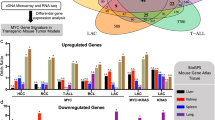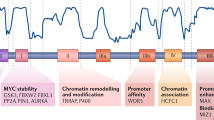Abstract
The ability of Myc to promote cellular transformation is well established; however, a better understanding of the mechanisms through which Myc mediates tumorigenesis is essential for the development of therapeutic approaches to target this potent oncoprotein. Structure–function studies in rodent fibroblast cells have provided the basis for much of our current understanding of these mechanisms. To build on these approaches, we have characterized three novel human cell line models of Myc-dependent transformation: MCF10A, SH-EP Tet21/N-Myc, and LF1/TERT/LT/ST cells. We have also evaluated Myc family proteins (c-Myc and L-Myc), a naturally occurring isoform of Myc (MycS), and a set of N-terminal domain mutants (ΔMBII, W135E, T58A) for their ability to promote anchorage-independent growth in these models. Taken together, these results provide the field with three new human cell-based models to study Myc activity, highlight the importance of cellular context, and challenge the paradigm that the ability of Myc to promote tumorigenesis is exclusively MBII-dependent.
This is a preview of subscription content, access via your institution
Access options
Subscribe to this journal
Receive 50 print issues and online access
$259.00 per year
only $5.18 per issue
Buy this article
- Purchase on Springer Link
- Instant access to full article PDF
Prices may be subject to local taxes which are calculated during checkout



Similar content being viewed by others
References
Adams JM, Harris AW, Pinkert CA, Corcoran LM, Alexander WS, Cory S et al. (1985). The c-myc oncogene driven by immunoglobulin enhancers induces lymphoid malignancy in transgenic mice. Nature 318: 533–538.
Bahram F, von der Lehr N, Cetinkaya C, Larsson LG . (2000). c-Myc hot spot mutations in lymphomas result in inefficient ubiquitination and decreased proteasome-mediated turnover. Blood 95: 2104–2110.
Bhatia K, Huppi K, Spangler G, Siwarski D, Iyer R, Magrath I . (1993). Point mutations in the c-Myc transactivation domain are common in Burkitt′s lymphoma and mouse plasmacytomas. Nat Genet 5: 56–61.
Breit S, Schwab M . (1989). Suppression of MYC by high expression of NMYC in human neuroblastoma cells. J Neurosci Res 24: 21–28.
Callus BA, Ekert PG, Heraud JE, Jabbour AM, Kotevski A, Vince JE et al. (2008). Cytoplasmic p53 is not required for PUMA-induced apoptosis. Cell Death Differ 15: 213–215.
Chang DW, Claassen GF, Hann SR, Cole MD . (2000). The c-Myc transactivation domain is a direct modulator of apoptotic versus proliferative signals. Mol Cell Biol 20: 4309–4319.
Chen W, Hahn WC . (2003). SV40 early region oncoproteins and human cell transformation. Histol Histopathol 18: 541–550.
Cleveland JL, Huleihel M, Bressler P, Siebenlist U, Akiyama L, Eisenman RN et al. (1988). Negative regulation of c-myc transcription involves myc family proteins. Oncog Res 3: 357–375.
Conzen SD, Gottlob K, Kandel ES, Khanduri P, Wagner AJ, O'Leary M et al. (2000). Induction of cell cycle progression and acceleration of apoptosis are two separable functions of c-Myc: transrepression correlates with acceleration of apoptosis. Mol Cell Biol 20: 6008–6018.
Cowling VH, D'Cruz CM, Chodosh LA, Cole MD . (2007). c-Myc transforms human mammary epithelial cells through repression of the Wnt inhibitors DKK1 and SFRP1. Mol Cell Biol 27: 5135–5146.
Debnath J, Muthuswamy SK, Brugge JS . (2003). Morphogenesis and oncogenesis of MCF-10A mammary epithelial acini grown in three-dimensional basement membrane cultures. Methods 30: 256–268.
Drayton S, Peters G . (2002). Immortalisation and transformation revisited. Curr Opin Genet Dev 12: 98–104.
Gregory MA, Qi Y, Hann SR . (2003). Phosphorylation by glycogen synthase kinase-3 controls c-myc proteolysis and subnuclear localization. J Biol Chem 278: 51606–51612.
Gustafson WC, Weiss WA . (2010). Myc proteins as therapeutic targets. Oncogene 29: 1249–1259.
Hahn WC, Counter CM, Lundberg AS, Beijersbergen RL, Brooks MW, Weinberg RA . (1999). Creation of human tumour cells with defined genetic elements. Nature 400: 464–468.
Hemann MT, Bric A, Teruya-Feldstein J, Herbst A, Nilsson JA, Cordon-Cardo C et al. (2005). Evasion of the p53 tumour surveillance network by tumour-derived MYC mutants. Nature 436: 807–811.
Herbst A, Hemann MT, Tworkowski KA, Salghetti SE, Lowe SW, Tansey WP . (2005). A conserved element in Myc that negatively regulates its proapoptotic activity. EMBO Rep 6: 177–183.
Kim SS, Shago M, Kaustov L, Boutros PC, Clendening JW, Sheng Y et al. (2007). CUL7 is a novel antiapoptotic oncogene. Cancer Res 67: 9616–9622.
Kuttler F, Ame P, Clark H, Haughey C, Mougin C, Cahn JY et al. (2001). c-myc box II mutations in Burkitt′s lymphoma-derived alleles reduce cell-transformation activity and lower response to broad apoptotic stimuli. Oncogene 20: 6084–6094.
Land H, Parada LF, Weinberg RA . (1983). Tumorigenic conversion of primary embryo fibroblasts requires at least two cooperating oncogenes. Nature 304: 596–602.
Landay M, Oster SK, Khosravi F, Grove LE, Yin X, Sedivy J et al. (2000). Promotion of growth and apoptosis in c-myc nullizygous fibroblasts by other members of the myc oncoprotein family. Cell Death Differ 7: 697–705.
Langdon WY, Harris AW, Cory S, Adams JM . (1986). The c-myc oncogene perturbs B lymphocyte development in E-mu-myc transgenic mice. Cell 47: 11–18.
Lutz W, Stohr M, Schurmann J, Wenzel A, Lohr A, Schwab M . (1996). Conditional expression of N-myc in human neuroblastoma cells increases expression of alpha-prothymosin and ornithine decarboxylase and accelerates progression into S-phase early after mitogenic stimulation of quiescent cells. Oncogene 13: 803–812.
Malynn BA, de Alboran IM, O'Hagan RC, Bronson R, Davidson L, DePinho RA et al. (2000). N-myc can functionally replace c-myc in murine development, cellular growth, and differentiation. Genes Dev 14: 1390–1399.
McMahon SB, Van Buskirk HA, Dugan KA, Copeland TD, Cole MD . (1998). The novel ATM-related protein TRRAP is an essential cofactor for the c-Myc and E2F oncoproteins. Cell 94: 363–374.
Meyer N, Penn LZ . (2008). Reflecting on 25 years with MYC. Nat Rev Cancer 8: 976–990.
Oster SK, Mao DY, Kennedy J, Penn LZ . (2003). Functional analysis of the N-terminal domain of the Myc oncoprotein. Oncogene 22: 1998–2010.
Penn LJ, Brooks MW, Laufer EM, Land H . (1990). Negative autoregulation of c-myc transcription. EMBO J 9: 1113–1121.
Prowse KR, Greider CW . (1995). Developmental and tissue-specific regulation of mouse telomerase and telomere length. Proc Natl Acad Sci USA 92: 4818–4822.
Schwab M . (2004). MYCN in neuronal tumours. Cancer Lett 204: 179–187.
Soule HD, Maloney TM, Wolman SR, Peterson Jr WD, Brenz R, McGrath CM et al. (1990). Isolation and characterization of a spontaneously immortalized human breast epithelial cell line, MCF-10. Cancer Res 50: 6075–6086.
Spotts GD, Patel SV, Xiao Q, Hann SR . (1997). Identification of downstream-initiated c-Myc proteins which are dominant-negative inhibitors of transactivation by full-length c-Myc proteins. Mol Cell Biol 17: 1459–1468.
Stewart TA, Pattengale PK, Leder P . (1984). Spontaneous mammary adenocarcinomas in transgenic mice that carry and express MTV/myc fusion genes. Cell 38: 627–637.
Stone J, de Lange T, Ramsay G, Jakobovits E, Bishop JM, Varmus H et al. (1987). Definition of regions in human c-myc that are involved in transformation and nuclear localization. Mol Cell Biol 7: 1697–1709.
Vervoorts J, Luscher-Firzlaff J, Luscher B . (2006). The ins and outs of MYC regulation by posttranslational mechanisms. J Biol Chem 281: 34725–34729.
Wei W, Jobling WA, Chen W, Hahn WC, Sedivy JM . (2003). Abolition of cyclin-dependent kinase inhibitor p16Ink4a and p21Cip1/Waf1 functions permits Ras-induced anchorage-independent growth in telomerase-immortalized human fibroblasts. Mol Cell Biol 23: 2859–2870.
Wood MA, McMahon SB, Cole MD . (2000). An ATPase/helicase complex is an essential cofactor for oncogenic transformation by c-Myc. Mol Cell 5: 321–330.
Wu J, Wong WW, Khosravi F, Minden MD, Penn LZ . (2004). Blocking the Raf/MEK/ERK pathway sensitizes acute myelogenous leukemia cells to lovastatin-induced apoptosis. Cancer Res 64: 6461–6468.
Acknowledgements
We would like to acknowledge technical assistance from Ms Caitlin Latimer. We thank the members of the Penn Lab for helpful discussions and critical review of this manuscript. This research was funded by a grant from the Canadian Cancer Society Research Institute (LZP), an Ontario Graduate Scholarship (AS), and a Canadian Breast Cancer Foundation Ontario Region Doctoral Fellowship (ARW). Additional support was provided by the Ontario Ministry of Health and Long Term Care. The views expressed do not necessarily reflect those of the OMOHLTC.
Author information
Authors and Affiliations
Corresponding author
Ethics declarations
Competing interests
The authors declare no conflict of interest.
Additional information
Supplementary Information accompanies the paper on the Oncogene website
Rights and permissions
About this article
Cite this article
Wasylishen, A., Stojanova, A., Oliveri, S. et al. New model systems provide insights into Myc-induced transformation. Oncogene 30, 3727–3734 (2011). https://doi.org/10.1038/onc.2011.88
Received:
Revised:
Accepted:
Published:
Issue Date:
DOI: https://doi.org/10.1038/onc.2011.88
Keywords
This article is cited by
-
MYCL promotes iPSC-like colony formation via MYC Box 0 and 2 domains
Scientific Reports (2021)
-
Multiple direct interactions of TBP with the MYC oncoprotein
Nature Structural & Molecular Biology (2019)
-
Lysine-52 stabilizes the MYC oncoprotein through an SCFFbxw7-independent mechanism
Oncogene (2017)
-
Inhibiting MYC binding to the E-box DNA motif by ME47 decreases tumour xenograft growth
Oncogene (2017)
-
MYC activity is negatively regulated by a C-terminal lysine cluster
Oncogene (2014)



